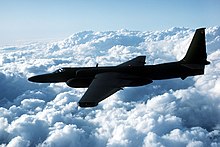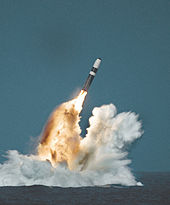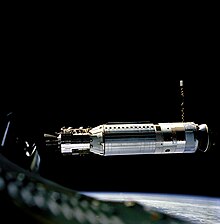Lockheed Corporation: Difference between revisions
Hydrargyrum (talk | contribs) m →Patrol and reconnaissance: link fix |
No edit summary |
||
| Line 10: | Line 10: | ||
}} |
}} |
||
The '''Lockheed Corporation''' (originally ''Loughead Aircraft Manufacturing Company'') was an [[United States|American]] [[aerospace]] company. Lockheed was founded in 1912 and later merged with [[Martin Marietta]] to form [[Lockheed Martin]] in [[1995 in aviation|1995]]. |
The '''Lockheed Corporation''' (originally ''Loughead Aircraft Manufacturing Company'') was an [[United States|Noth American]] (is not american, the Suth is America too) [[aerospace]] company. Lockheed was founded in 1912 and later merged with [[Martin Marietta]] to form [[Lockheed Martin]] in [[1995 in aviation|1995]]. |
||
==History== |
==History== |
||
Revision as of 22:34, 6 March 2010
 | |
| Founded | 1912 |
|---|---|
| Defunct | 1995 |
| Fate | Merged with Martin Marietta |
| Successor | Lockheed Martin |
| Headquarters | Burbank, California |
The Lockheed Corporation (originally Loughead Aircraft Manufacturing Company) was an Noth American (is not american, the Suth is America too) aerospace company. Lockheed was founded in 1912 and later merged with Martin Marietta to form Lockheed Martin in 1995.
History
This section needs additional citations for verification. (May 2009) |
Origins
The Alco Hydro-Aeroplane Company was established in 1912 by the brothers Allan and Malcolm Loughead. This company was renamed the Loughead Aircraft Manufacturing Company and located in Santa Barbara, California.
In 1926, following the failure of Loughead, Allan Loughead formed the Lockheed Aircraft Company (the spelling was changed to match its phonetic pronunciation) in Hollywood, California. In 1929 Lockheed sold out to Detroit Aircraft Corporation.
The Great Depression ruined the aircraft market, and Detroit Aircraft went bankrupt. A group of investors headed by brothers Robert and Courtland Gross, and including Walter Varney bought the company out of receivership in 1932. The syndicate bought the company for a mere $40,000. Ironically, Allan Loughead himself had planned to bid for his own company, but had raised "only" $50,000, which he felt was too small a sum for a serious bid.
In 1934, Robert E. Gross was named chairman of the new company, the Lockheed Corporation, which was headquartered at the airport in Burbank, California. His brother Courtlandt S. Gross was a co-founder and executive, succeeding Robert as Chairman following his death in 1961.
The first successful construction that was built in any number (141 aircraft) was the Vega, best known for its use to several first- and record setting flights by, among others, Amelia Earhart, Wiley Post and George Hubert Wilkins.
In the 1930s, Lockheed spent $139,400 to develop the Model 10 Electra, a small twin-engine transport. The company sold 40 in the first year of production. Amelia Earhart and her navigator, Fred Noonan, flew this plane on their failed attempt to circumnavigate the world in 1937. Follow-on designs, the Lockheed Model 12 Electra Junior and the Lockheed 14 Super Electra expanded their market. The Lockheed 14 also formed the basis for the Hudson bomber, which was supplied to both the British Royal Air Force and the United States military before and during World War II. Its primary role was submarine hunting.
Production during World War II

At the beginning of World War II, Lockheed — under the guidance of Clarence (Kelly) Johnson, who is considered one of the best known American aircraft designers — answered a specification for an interceptor by submitting the P-38 Lightning fighter plane, a somewhat unorthodox twin-engine, twin-boom design. The P-38 was the only U.S. fighter design to be built for the entire duration of the war. It filled ground attack, air-to-air, and even strategic bombing roles in all theaters of the war in which the United States operated. The P-38 was responsible for shooting down more Japanese aircraft than any other U.S. Army Air Force type during the war; and is particularly famous for being the airplane that shot down Japanese Admiral Isoroku Yamamoto's airplane.
The Lockheed Vega factory was located next to Burbank's Union Airport which it had purchased in 1940. During the war, the entire area was camouflaged to fool enemy aerial reconnaissance. The factory was hidden beneath a huge burlap tarp painted to depict a peaceful semi-rural neighborhood, replete with rubber automobiles.[1][2] Hundreds of fake trees, shrubs, buildings and even fire hydrants were positioned to give a three dimensional appearance. The trees and shrubs were created from chicken wire treated with an adhesive and covered with feathers to provide a leafy texture.[3]
All told, Lockheed and its subsidiary Vega produced 19,278 aircraft during World War II, representing six percent of those produced in the war. This included 2,600 Venturas, 2,750 B-17 Flying Fortresses (built under license from Boeing), 2,900 Hudsons, and 9,000 Lightnings.[4]
Postwar production
During World War II, Lockheed, in cooperation with Trans-World Airlines (TWA), had developed the L049 Constellation, a radical new airliner capable of flying 43 passengers between New York and London at a speed of 300 mph in 13 hours. Once the Constellation (affectionately called "Connie") went into the production, the military received the first production models. After the war, the airlines received their original orders of Constellations. This gave Lockheed more than a year's head-start over other aircraft manufacturers in what was easily foreseen as the post-war modernisation of civilian air travel. The Constellations performance set new standards which did in fact transform the civilian transportation market, but its signature tri-tail was the result of many of their initial customers not having hangars tall enough for a more conventional tail.
Lockheed produced a larger transport, the double-decked R6V Constitution, which was intended to make the Constellation obsolete. However, the design proved underpowered, and only two prototypes were ever built.
Skunk Works



In 1943, Lockheed began, in secrecy, development of a new jet fighter at its Burbank facility. This fighter, the P-80 Shooting Star, became the first American jet fighter to score a kill. It also recorded the first jet-to-jet aerial kill, downing a MiG-15 in Korea, although by this time the F-80 (as it came to be known in June 1948) was already considered obsolete.[5]
Starting with the P-80, Lockheed's secret development work was conducted by its Advanced Development Division, more commonly known as the Skunk Works. The name was taken from Al Capp's comic strip Li'l Abner. This organization has become famous and has spawned many successful Lockheed designs, including the U-2 (late 1950s), SR-71 Blackbird (1962) and F-117 Nighthawk stealth fighter (1970s). The Skunk Works often created high quality designs in a short time and sometimes with limited resources. Today the generic term "skunk works" implies a place for the development of secret projects.
Projects during the Cold War
In 1954, the C-130 Hercules, a durable four-engined transport, flew for the first time. The type remains in production to present day.
In 1956, Lockheed received a contract for the development of the Polaris Submarine Launched Ballistic Missile (SLBM), this would be followed by the Poseidon and Trident nuclear missiles.
Lockheed developed the F-104 Starfighter in late 1950s, the world's first Mach 2 fighter jet. In the early 1960s the company the C-141 Starlifter four-engine jet transport.
During the 1960s, Lockheed began development for two large aircraft: the C-5 Galaxy military transport and the L-1011 TriStar wide-body civil airliner. Both projects encountered delays and cost overruns. The C-5 was built to unclear initial requirements and suffered from structural weaknesses, which Lockheed was forced to correct with its own money. The Tristar competed for the same market as the Douglas DC-10; delays in Rolls-Royce engine development caused the Tristar to fall behind the DC-10. The C-5 and L-1011 projects, along with the (canceled) U.S. Army AH-56 Cheyenne Helicopter program and embroiled shipbuilding contracts, caused Lockheed to lose massive sums of money during the 1970s.
Already drowning in debt, Lockheed (then the number one U. S. defense contractor) asked the U.S. Government for a loan guarantee, to avoid certain insolvency. The measure was hotly debated in the U.S. Senate. The chief antagonist was Senator William Proxmire (D-Wis), the nemesis of Lockheed and its chairman, Daniel J. Haughton. Following a fierce debate, Vice President Spiro T. Agnew cast a tie-breaking vote in favor of the measure.
Bribery scandals
The Lockheed bribery scandals were a series of illegal bribes and contributions made by Lockheed officials from the late 1950s to the 1970s. In late 1975 and early 1976, a sub-committee of the U.S. Senate led by Senator Frank Church concluded that members of the Lockheed board had paid members of friendly governments to guarantee contracts for military aircraft.[6] In 1976, it was publicly revealed that Lockheed had paid $22 million in bribes to foreign officials[7] in the process of negotiating the sale of aircraft including the F-104 Starfighter, the so-called "Deal of the Century".
The scandal caused considerable political controversy in West Germany, the Netherlands, Italy and Japan. In the U.S. the scandal led to passage of the Foreign Corrupt Practices Act, and nearly led to the ailing corporation's downfall (it was already struggling due to the poor sales of the L-1011 airliner). Haughton resigned his post as chairman of Lockheed.
Timeline
- 1912: The Alco Hydro-Aeroplane Company established.
- 1916: Company renamed Loughead Aircraft Manufacturing Company.
- 1926: Lockheed Aircraft Company formed.
- 1929: Lockheed becomes a division of Detroit Aircraft.
- 1932: Robert and Courtland Gross take control of company after the bankruptcy of Detroit Aircraft. Company renamed Lockheed Aircraft Corporation, recognizing the company's reorganization under a board of directors.
- 1943: Lockheed's Skunk Works founded in Burbank, California.
- 1954: First flight of the C-130 Hercules.
- 1954: Maiden flight of the U-2.
- 1976: The Lockheed bribery scandals.
- 1977: Company renamed Lockheed Corporation, to reflect non-aviation activities of the company.
- 1978: The company's Hollywood-Burbank Airport is sold to its nearby cities and becomes Burbank-Glendale-Pasadena Airport (later renamed Bob Hope Airport in 2003).[8]
- 1985: Acquires Metier Management Systems.
- 1986: Acquires Sanders Associates electronics of Nashua, New Hampshire.
- 1991: Lockheed, General Dynamics and Boeing begin development of the F-22 Raptor.
- 1992: All aerospace related activities end at the Burbank facility.
- 1993: Acquires General Dynamics' Fort Worth aircraft division, builder of the F-16 Fighting Falcon.
- 1995: Lockheed Corporation merges with Martin Marietta to form Lockheed Martin.
Divisions
Lockheed's operations are divided between several groups and divisions, many of which continue to operate within Lockheed Martin.[9]
- Aeronautical Systems Group
- Lockheed-California Company (CALAC), Burbank, California.
- Lockheed-Georgia Company (GELAC), Marietta, Georgia.
- Lockheed Advanced Aeronautics Company, Saugus, California.
- Lockheed Aircraft Service Company (LAS), Ontario, California.
- Lockheed Air Terminal, Inc. (LAT), Burbank, California, now Bob Hope Airport and owned by the Burbank-Glendale-Pasadena Airport Authority.
- Missiles, Space, and Electronics Systems Group
- Lockheed Missiles & Space Company, Inc., Sunnyvale, California.
- Lockheed Space Operations Company, Titusville, Florida.
- Lockheed Engineering and Management Services Company, Inc., Houston, Texas.
- Lockheed Electronics Company, Inc., Plainfield, New Jersey.
- Marine Systems Group
- Lockheed Shipbuilding Company, Seattle, Washington.
- Lockport Marine Company, Portland, Oregon.
- Advanced Marine Systems, Santa Clara, California.
- Information Systems Group
- Datacom Systems Corporation, Teaneck, New Jersey.
- CADAM Inc., Burbank, California.
- Lockheed Data Plan, Inc., Los Gatos, California.
- DIALOG Information Services, Inc, Palo Alto, California.
- Metier Management Systems, London, England.
- Integrated Systems and Solutions, Gaithersburg, MD.
Product list



A partial listing of aircraft and other vehicles produced by Lockheed.
Airliners and civil transports
- Lockheed Vega
- Lockheed Model 10 Electra
- Lockheed Model 12 Electra Junior
- Lockheed Model 14 Super Electra
- Lockheed Lodestar
- Lockheed Constellation, famous airliner
- Lockheed Saturn
- L-188 Electra
- Lockheed JetStar, business jet
- L-1011 TriStar, wide-body airliner
Military transports
- C-69/C-121, military transport versions of the Constellation
- Lockheed R6V Constitution, large transport aircraft
- C-130 Hercules, medium combat transport (AC-130 gunship) (other variants)
- C-141 Starlifter, long-range jet transport
- C-5 Galaxy, heavy transport
Fighters
- P-38 Lightning, twin-engine counter-rotating propeller fighter
- P-80 Shooting Star, the United States Air Force's first operational jet fighter
- T-33 Shooting Star, trainer jet
- F-94 Starfire, all-weather fighter
- F-104 Starfighter, multi-mission fighter, the "missile with a man in it"
- F-117 Nighthawk, "stealth fighter" attack aircraft
- F-16 Fighting Falcon, multirole fighter (Originally General Dynamics)
- F-22 Raptor, air superiority stealth fighter
Patrol and reconnaissance
- Lockheed Hudson, maritime patrol/bomber
- PV-1 Ventura and PV-2 Harpoon, Maritime patrol/bomber
- P-2 Neptune, maritime patrol
- P-3 Orion, ASW patrol
- Lockheed U-2, reconnaissance (TR-1)
- SR-71 Blackbird, reconnaissance (A-12) (M-21) (YF-12)
- S-3 Viking, patrol/attack
- YO-3A Quiet Star
Helicopters
- CL-475, rigid-rotor helicopter
- XH-51A/B (Lockheed CL-595/Model 286), compound helicopter testbed
- AH-56 Cheyenne, prototype attack compound helicopter
Missiles
Space technology
Sea vessels
See also
References
- ^ "World War II-Lockheed Burbank Aircraft Plant Camouflage". Amazing Posts. 16 August 2008.
- ^ How to Hide an Airplane Factory
- ^ "California Becomes a Giant Movie Set". Flat Rock. 16 July 2009.
- ^ TIME, January 14, 1946.
- ^ Service History
- ^ FJS (German language)
- ^ Time magazine
- ^ History of Burbank, The Changing Face of the City, City of Burbank Website
- ^ Francillon, René J. Lockheed Aircraft since 1913. Annapolis: Naval Institute Press, 1987, pp. 47-49.
Further reading
- Boyne, Walter J. Beyond the Horizons: The Lockheed Story. New York: St. Martin's Press, 1998. ISBN 0-312-19237-1.
- Allen, Richard Sanders Revolution In The Sky Brattleboro, VT: The Stephen Greene Press, 1964. LOC 63-20452.
External links
- Lockheed Brothers from PBS
- The Jetmakers
- Kakuei Tanaka - A political biography of modern Japan: "Chapter 4 The Lockheed Scandal" (The Kodama organization, a Yakuza gang, got mixed up in this scandal.)
- Lockheed history on lockheedmartin.com
- Camouflaged plant during WW II
- Lockheed Corporation
- Companies established in 1912
- Companies disestablished in 1995
- Defunct aircraft manufacturers of the United States
- Lockheed Martin
- Political scandals in Japan
- Companies based in Santa Barbara County, California
- Companies based in Los Angeles, California
- Burbank, California
- Defunct companies based in California
